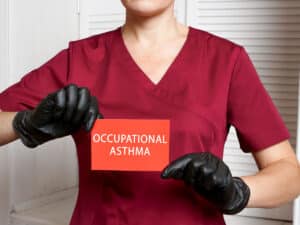Asthma is both incurable and deadly.
The chronic, long-term respiratory condition narrows the lung’s airways by swelling them up and, in some cases, producing extra mucus. That narrowing creates breathing difficulties which, sometimes, can be life-threatening.
With no known cure for asthma, your only option is to manage it through treatment.
According to the CDC, 17 percent of all adult-onset asthma cases are related to occupational exposure, making it the most prevalent workplace-related respiratory disease. Additionally, the CDC revealed that over a 17-year time span, approx. 20 percent of the 33,300-plus asthma-related deaths were caused by on-the-job exposure… many of which were preventable.
There are two main categories of work-related asthma, which are:
- Occupational/work-induced asthma, and
- Work-exacerbated asthma (also known as work-aggravated asthma).
In this article, we provide you with a breakdown of occupational asthma, its main triggers, some symptoms to look for, and guidelines to both prevent and manage it.

Causes of occupational asthma
It’s dangerous enough to breathe in certain fumes and dusts at work, which is why OSHA is so strict about environmental safety for substances such as silica and asbestos, as well as respirator fit testing.
But, when you’re asthmatic and you inhale a substance that triggers it, your immune system reacts very strongly by swelling your airway and oftentimes creating more mucus. Additionally, the muscles surrounding your airway may also tighten, making it much harder to breathe. Over time, those airway walls can even thicken.
As of 2023, there are over 300 workplace substances that have been identified as probable causes of occupational asthma. These substances include, but are not limited to the following:
- Chemicals – some chemicals used to manufacture paints, varnishes, adhesives, laminates and soldering resin. Others are chemicals used to make insulation, packaging materials, and foam mattresses and upholstery.
- Animal substances – these substances are proteins found in dander, hair, scales, fur, saliva and body wastes could cause work-place related asthma.
- Enzymes – some enzymes used in detergents and flour conditioners could also lead to occupational asthma.
- Respiratory irritants – some irritants such as chlorine gas, sulfur dioxide, wood dust, crystalline silica, and smoke could also lead to or aggravate asthma.
- Metals – some metals, particularly platinum, chromium and nickel sulfate, have a high possibility of causing occupational asthma.
- Plant substances – some plant-based substances, such as proteins found in natural rubber latex, flour, flax, cereals, cotton, hemp, rye, wheat and papain [a digestive enzyme derived from papaya].
Now that you know some of the causes, let’s break down some related symptoms.

Symptoms to watch for
If you or a team member suspect that you’re dealing with the effects of occupational asthma, here are some symptoms you may experience:
- Wheezing,
- runny nose,
- shortness of breath,
- nasal congestion,
- eye irritation, and
- tightness of the chest.
While these symptoms alone don’t necessarily mean that you have asthma, it’s important that if you experience any or all of them, you speak with a licensed medical professional.
Also, if the symptoms worsen while you’re at work and exposed to the triggering substance(s), and tend to subside when you’re away from work, then it’s likely work-related.

Prevention and OSHA guidelines
It might seem general and obvious, but avoiding the irritants altogether is the best prevention.
Your workplace can and should also implement adequate control methods to prevent worker’s exposures, use less harmful substances and provide personal protective equipment (PPE). Additionally, your doctor may prescribe medication to help relieve symptoms and control then inflammations associated with this type of asthma.
As for the health and safety standards, according to OSHA guidelines, employers are required to keep a material safety data sheet (MSDS) for each hazardous chemical used in the workplace. Furthermore, you’ll need to follow OSHA’s respiratory standard for everything from respirator fit testing to medical surveillance testing.

Working with Worksite Medical
In most cases, OSHA requires medical surveillance testing, and at no cost to employees.
Worksite Medical makes that program easier with mobile medical testing.
We conduct on-site respirator fit tests, as well as audiometric exams, pulmonary function tests and heavy metal lab work, right on your job site. We also keep accurate, easy-to-access medical records for your convenience. You’ll keep your employees at work, and stay ahead of OSHA inspections.
With Worksite Medical, a mobile medical testing unit (take a virtual tour here) — we can bring all the resources of a lab to you. Our certified lab technicians can perform both qualitative and quantitative respirator tests to ensure a perfect fit.
Protect your team and your workplace from issues such as occupational asthma now with Worksite Medical.
Not sure what you need? Try our medical testing wizard here.
Give us a call at 1-844-622-8633, or complete the form below to schedule an on-site visit or to get your free quote!




